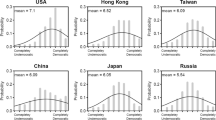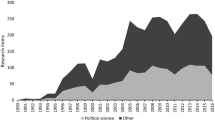Abstract
We examine the question of whether or not reducing the costs of voting by conducting elections entirely through the mail rather than at the traditional polling place increases participation. Using election data from Oregon, we examine whether or not elections conducted through the mail increase turnout in both local and statewide elections. Using precinct-level data merged with census data we also examine how postal voting may alter the composition of the electorate. We find that, while all-mail elections tend to produce higher turnout, the most significant increases occur in low stimulus elections, such as local elections or primaries where turnout is usually low. The increase in turnout, however, is not uniform across demographic groups. Voting only by mail is likely to increase turnout among those who are already predisposed to vote, such as those with higher socioeconomic status. Like other administrative reforms designed to make voting easier, postal voting has the potential to increase turnout. However, the expanded pool of voters will be limited most likely to those already inclined to vote but find it inconvenient to go to the polling place. This conclusion is consistent with the growing body of research that suggests that relaxing administrative requirements is not likely to be the panacea for low turnout among the disenfranchised.
Similar content being viewed by others
REFERENCES
Brians, Craig L. and Grofman, Bernard (1999). When registration barriers fall, who votes? An empirical test of the rational choice model. Public Choice 99: 161–176.
California Secretary of State (1996).Election statistics .[On-line ].Available:http://www.ss.ca.gov/elections/elections_u.htm.
Calvert., J., and Gilchrist, J. (1993). Suppose they held an election and almost everybody came! PS: Political Science & Politics 24: 695–700.
Census of Population and Housing (1990). Summary tape file 3 on CD-ROM [machinereadable data files] / prepared by the Bureau of the Census. Washington: The Bureau [producer and distributor], 1992.
Downs, Anthony (1957). An Economic Theory of Democracy. New York: Harper & Row.
Dubin, Jeffrey A., and Kalsow, Gretchen A. (1996). Comparing absentee and precinct voters: a view over time. Political Behavior 18: 369–411.
Flowerdew, Robin, Green, Mick, and Kehris, Evangelos (1991). Using areal interpolation methods in geographic information systems. Papers in Regional Science 70: 303–315.
Goodchild, Michael F., and Siu-Ngan Lam, Nina (1980). Areal interpolation: A variant of the traditional spatial problem. Geo-processing 1: 297–312.
Hamilton, Randy (1988.) American all-mail balloting: a decade's experience. Public Administration Review 48: 860–866.
Jeffe, Douglas, and Jeffe, Sherry Bebitch (1990). Absence counts: voting by mail. The American Enterprise November/December: 19–21.
Karp, Jeffrey A., and Banducci, Susan A. (in press). Absentee voting, participation, and mobilization. American Politics Quarterly.
King, Gary, Keohane, Robert O., and Verba, Sidney (1994). Designing Social Inquiry. Princeton, NJ: Princeton University Press.
Magleby, David B. (1987). Participation in mail ballot elections. Western Political Quarterly41: 79–91.
Markus, Gregory (1979). Analyzing Panel Data (Sage University Paper Series, Quantitative Applications in the Social Science). Beverly Hills, CA: Sage.
New Zealand Press Association. (1997, December 2). Technology may change the way we vote.
Oliver, J. Eric (1996). The effects of eligibility restrictions and party activity on absentee voting and overall turnout. American Journal of Political Science 40: 498–513.
Oregon Secretary of State (1998). Estimates of financial impact, state ballot measures[On-line]. Available: http://www.sos.state.or.us/elections/nov398/other.info/fiscal.htm.
Oregon Secretary of State (1996). Official election participation statistics. November 5. [On-line]. Available: http://www.sos.state.or.us/elections/nov596/other.info/totbycty. htm.
Piven, Frances Fox, and Cloward, Richard A. (1988). Why Americans Don't Vote. New York: Pantheon Books.
Riker, William H., and Ordeshook, Peter C. (1968). A theory of the calculus of voting. American Political Science Review 62: 25–42.
Rosenfield, Margaret (1995). All Mail Ballot Elections. Innovations in Election Administration. Washington, DC: The National Clearinghouse on Election Administration/ Federal Election Commission.
Rosenstone, Steven J., and Hansen, John Mark (1993). Mobilization, Participation, and Democracy in America. New York: Macmillan Publishing Company.
Southwell, Priscilla L. and Burchett, Justin (2000). The effect of all-mail elections on voter turnout. American Politics Quarterly 28: 72–79.
Southwell, Priscilla L., and Burchett, Justin (1997). Survey of vote-by-mail senate election in the state of Oregon. PS: Political Science & Politics 30: 53–57.
Stein, Robert M., and Garcia-Monet, Patricia A. (1995). Voting early but not often. Social Science Quarterly 78: 657–671.
Teixeira, Ruy A. (1992). The Disappearing American Voter. Washington, DC: The Brookings Institution.
Traugott, Michael W. (1996). Report on the characteristics of the Oregon electorate participating in the special general election for the U.S. Senate on January 30, 1996. Ann Arbor, MI: Institute for Social Research.
Washington Secretary of State (1996). Election Statistics [On-line]. Available: http:// www.wa.gov/sec/elections.htm.
Wolfinger, Raymond E., and Rosenstone, Steven J. (1980). Who Votes? New Haven: Yale University Press.
Author information
Authors and Affiliations
Rights and permissions
About this article
Cite this article
Karp, J.A., Banducci, S.A. Going Postal: How All-Mail Elections Influence Turnout. Political Behavior 22, 223–239 (2000). https://doi.org/10.1023/A:1026662130163
Issue Date:
DOI: https://doi.org/10.1023/A:1026662130163




